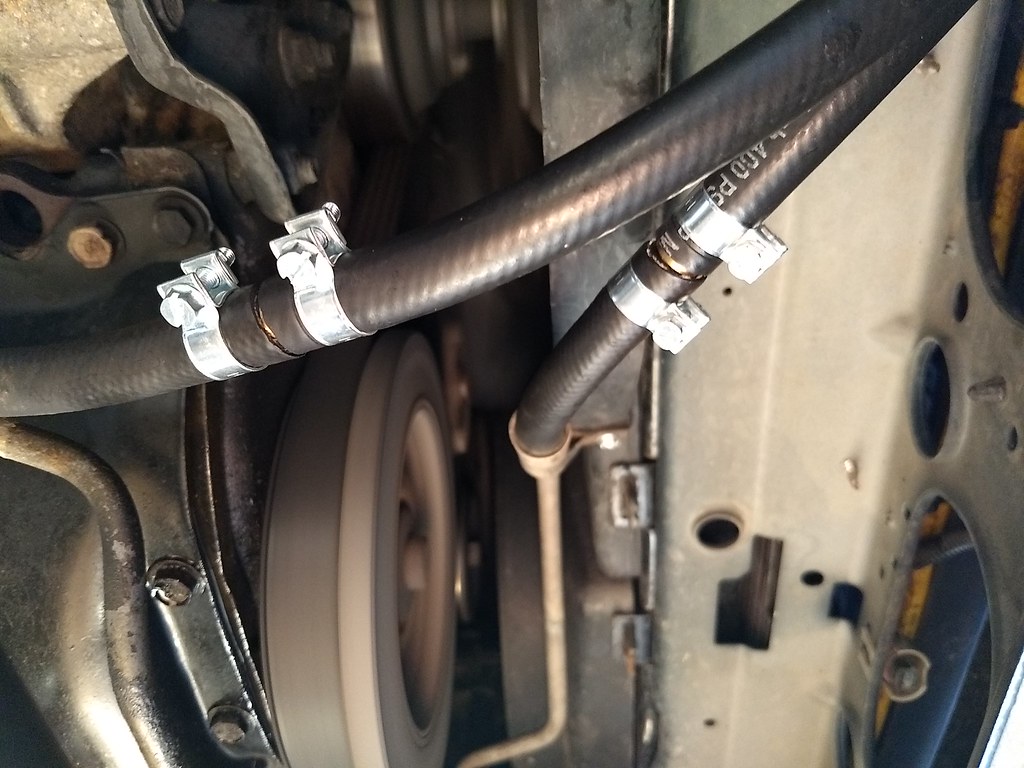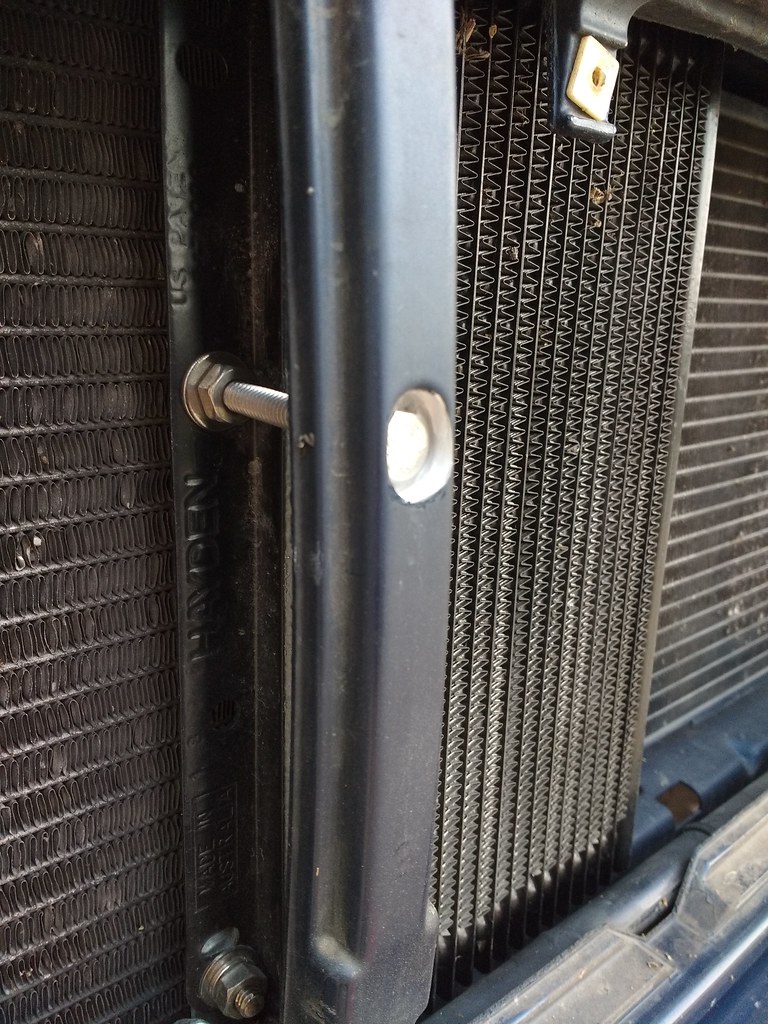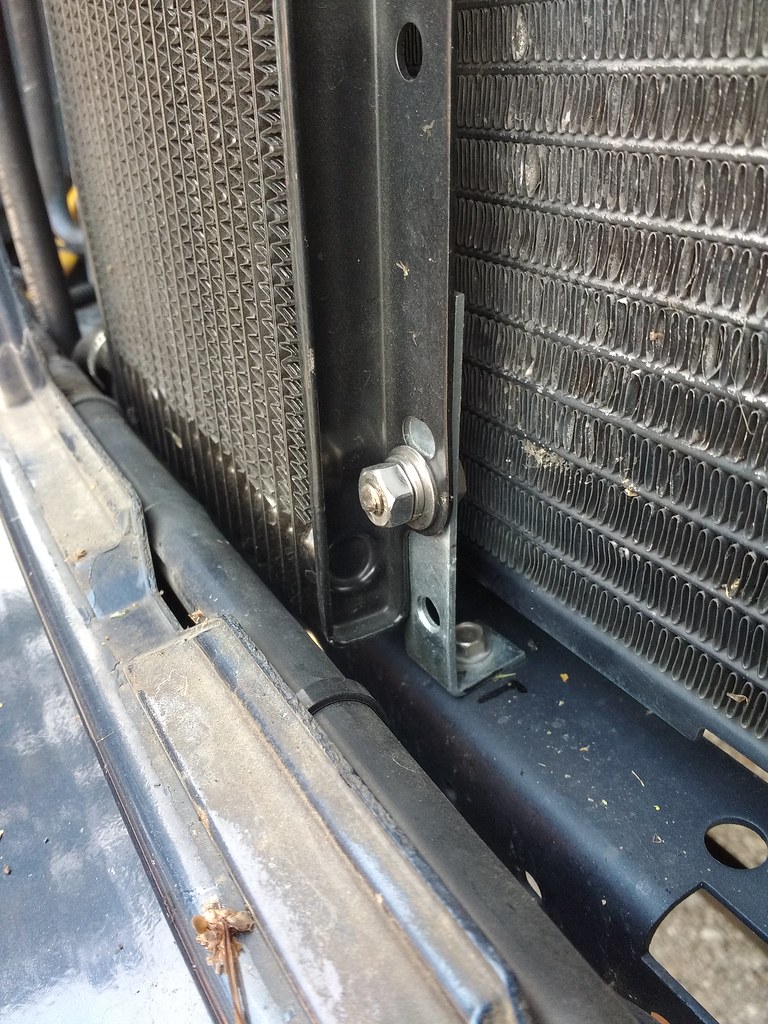Transmission cooler question
#1
Newbie
Thread Starter
Join Date: Dec 2011
Location: Northern California
Posts: 6
Likes: 0
Received 0 Likes
on
0 Posts
Year: 1999
Model: Cherokee(XJ)
Engine: 4.0
I have a 99 XJ sport with 31” tires, 4.0L engine. I am seriously looking at adding a 2nd tranny cooler on it. Major reason why is that the tranny works much better when its cooler out. I am also approaching 190K on it and I am told that is the start of the mileage range for tranny failure. Just trying to extend its life  . I live in the high desert and occasionally need to tow through the mountains.
. I live in the high desert and occasionally need to tow through the mountains.
So the question is should I splice the tranny lines and add a 2nd cooler to operate in conjunction with OR cap off the stock cooler that is inside the radiator and just run with an arftermarket cooler mounted outside the radiator?
 . I live in the high desert and occasionally need to tow through the mountains.
. I live in the high desert and occasionally need to tow through the mountains.So the question is should I splice the tranny lines and add a 2nd cooler to operate in conjunction with OR cap off the stock cooler that is inside the radiator and just run with an arftermarket cooler mounted outside the radiator?
#2
CF Veteran
Join Date: Oct 2015
Posts: 7,355
Likes: 0
Received 1,530 Likes
on
1,173 Posts
Year: 2000
Model: Cherokee (XJ)
My buddy runs something like this on his Dodge Dualie Diesel that he tows his race trailer with. No idea where you would put it in on a Jeep though. His is not huge but.......
https://www.summitracing.com/parts/d...SABEgIg5fD_BwE
https://www.summitracing.com/parts/d...SABEgIg5fD_BwE
#3
CF Veteran
The easiest way to do it is keep the stock cooler in the radiator and cut the return line and put 2 barbed fittings in it and run it through the aftermarket cooler, make sure the the aftermarket one is plumed in after the radiator, and for best efficientcy the fluid should enter in the bottom of the cooler and exit at the top. The Hayden 405 cooler is a good option for cheap.
#6
CF Veteran
It will still work the other way but may not be as effective, when the fluid is going into the bottom first it has to fill the whole cooler because it is working against gravity so the fluid has more time to cool if that makes sense.
#7
CF Veteran
Join Date: Oct 2011
Location: SEMO
Posts: 1,394
Likes: 0
Received 7 Likes
on
7 Posts
Year: 2000
Model: Cherokee (XJ)
Engine: 4.0 L6
I'm not sure that the flow through the cooler will be much different depending on routing. That would depend on how much restriction to flow there is in the cooler, but filling it from bottom to top will eliminate air pockets in the cooler, making it more effective. When the cooler first fills up after startup, the fluid will push all the air out.
Last edited by Tbone289; 07-05-2018 at 04:08 PM.
Trending Topics
#8
CF Veteran
Join Date: Jan 2016
Location: Newport News, VA
Posts: 1,242
Likes: 0
Received 38 Likes
on
37 Posts
Year: 96 & 88 4 dr Cherokees
Don't forget, heat rises, so technically, you'd want the hottest fluid up top, not on the bottom so you don't warm it back up.
And the stock heat exchanger doesn't cool unless the transmission is hotter then the coolant, and if that is true, you're already in trouble. Only time it is gonna cool the trans fluid is if the trans fluid is already too hot.
It does heat the transmission up to operating temp much quicker than it would heat up on it's own for less wear, especially in colder climates, and helps to maintain it there. That is why a good aftermarket cooler has a thermostatic valve to control when flow goes thru the extra cooler so the stock heat exchanger can do it's job.
That's why the stock one is called a heat exchanger, not a transmission cooler, as it heats up and cools down (if it's too hot) the trans fluid, but an aftermarket unit is only a cooler, all it does is cool...no heat source to heat up with.
.
Last edited by TRCM; 07-05-2018 at 05:49 PM.
#9
CF Veteran
Join Date: Oct 2011
Location: SEMO
Posts: 1,394
Likes: 0
Received 7 Likes
on
7 Posts
Year: 2000
Model: Cherokee (XJ)
Engine: 4.0 L6
Here's the temperature of the left-side tank after driving at full operating temperature:

Last edited by Tbone289; 07-06-2018 at 10:50 AM.
#10
CF Veteran
Join Date: Oct 2011
Location: SEMO
Posts: 1,394
Likes: 0
Received 7 Likes
on
7 Posts
Year: 2000
Model: Cherokee (XJ)
Engine: 4.0 L6
An air conditioner is a heat exchanger, as is a refrigerator, a radiator, or even a heater. You can't cool anything without an exchange of heat. Calling a fluid to fluid heat exchanger like the stock setup, or a fluid to air heat exchanger like an aux cooler a "cooler" is not incorrect. They both are heat exchangers, as they both exchange heat to cool the fluid. The only difference is that the heat exchange can go both ways in the stock cooler, due to the differing temperatures between the fluids.
Most manufacturers call the radiator-type exchanger a cooler, because that is what it's doing the vast majority of the time, and cooling the transmission fluid is its primary function. Heating the transmission fluid is a secondary function.
Last edited by Tbone289; 07-06-2018 at 01:32 PM.
#11
Newbie
Thread Starter
Join Date: Dec 2011
Location: Northern California
Posts: 6
Likes: 0
Received 0 Likes
on
0 Posts
Year: 1999
Model: Cherokee(XJ)
Engine: 4.0
Thank you for all the great information! I like the idea of splitting the lines in order to keep the stock exchanger. The tranny just shifts and runs better when it is on the cooler side. I was looking at putting the second exchanger on the front of the radiator. What would be the potential pitfalls in that? I do live and work in the mountains and will drive in temps ranging from -10 to 95.
#12
CF Veteran
Join Date: Oct 2011
Location: SEMO
Posts: 1,394
Likes: 0
Received 7 Likes
on
7 Posts
Year: 2000
Model: Cherokee (XJ)
Engine: 4.0 L6
No pitfalls. I recommend you put it at least partially in front of the mechanical fan so that there's some air flowing through it 100% of the time the engine is running, even when you're stopped.
Here's a pic of where I spliced the aux cooler in. The 2000 XJ has a rubber portion in the return line where you want the cooler installed. I'm thinking your '99 will be the same, but you can double-check that by looking at where it enters the transmission. The return line is the rearmost line on the transmission. I just cut and spliced in with brass 3/8" barb connectors and fuel line style clamps:

I mounted it with brackets to the lower core support, and one bolt through a grille support. I don't recommend using the zip-tie mounts that come with the coolers.


Here's a pic of where I spliced the aux cooler in. The 2000 XJ has a rubber portion in the return line where you want the cooler installed. I'm thinking your '99 will be the same, but you can double-check that by looking at where it enters the transmission. The return line is the rearmost line on the transmission. I just cut and spliced in with brass 3/8" barb connectors and fuel line style clamps:

I mounted it with brackets to the lower core support, and one bolt through a grille support. I don't recommend using the zip-tie mounts that come with the coolers.


Last edited by Tbone289; 07-06-2018 at 04:46 PM.
#13
CF Veteran
Join Date: Oct 2011
Location: SEMO
Posts: 1,394
Likes: 0
Received 7 Likes
on
7 Posts
Year: 2000
Model: Cherokee (XJ)
Engine: 4.0 L6
In your climate, I would re-iterate TRCM's suggestion to get a cooler with a thermal bypass valve. You don't want to over cool your fluid in those cold temperatures.
I don't have one, and even here in the lower midwest I block the air through the cooler on the coldest days.
I don't have one, and even here in the lower midwest I block the air through the cooler on the coldest days.
#14
CF Veteran
Join Date: Jan 2016
Location: Newport News, VA
Posts: 1,242
Likes: 0
Received 38 Likes
on
37 Posts
Year: 96 & 88 4 dr Cherokees
At full operating temperature, the coolant temperature in the "cool" side of the radiator where the heat exchanger is, most of the time is cooler than the transmission fluid is. I've taken IR readings on that side of the radiator, and the tank is usually in the 130-160 degree range. I would agree that you would be in trouble if the coolant in the radiator was near the temperatures in the block, but it never is. If it was, you would have some serious cooling problems.
Here's the temperature of the left-side tank after driving at full operating temperature:

Here's the temperature of the left-side tank after driving at full operating temperature:

OK, that is normal operating temp with the vehicle idling in the driveway...not driving down the road with a real load on it.
BTW, the trans temp in my Ram ain't much more than that going down the road (130-150 deg normally, which is the result of the stock transmission cooler, not the heat exchanger some call a cooler in the radiator).
Most people call what's under their hood a motor too, when it is really an engine. Motors are electrical, not an internal combustion engine. Just because someone else does it don't mean it is right.

It maintains a temp, which requires cooling and heating...hence heat exchanger, not cooler. I've run many vehicles without one, and with the stock and aftermarket cooler inline....the trans temp reading is still the same, which tells me the stock cooler is maintaining, not cooling, as if it was cooling, then the trans temp would be lower with both, but it isn't.
An air conditioner is a heat exchanger, as is a refrigerator, a radiator, or even a heater. You can't cool anything without an exchange of heat. Calling a fluid to fluid heat exchanger like the stock setup, or a fluid to air heat exchanger like an aux cooler a "cooler" is not incorrect. They both are heat exchangers, as they both exchange heat to cool the fluid. The only difference is that the heat exchange can go both ways in the stock cooler, due to the differing temperatures between the fluids.
Most manufacturers call the radiator-type exchanger a cooler, because that is what it's doing the vast majority of the time, and cooling the transmission fluid is its primary function. Heating the transmission fluid is a secondary function.
Most manufacturers call the radiator-type exchanger a cooler, because that is what it's doing the vast majority of the time, and cooling the transmission fluid is its primary function. Heating the transmission fluid is a secondary function.
Never said you were wrong, but the stock heat exchanger is designed to heat the fluid up more so than cool it down, and then hold it there to reduce the friction inside the transmission from too thick of a fluid (too cold).
An aftermarket cooler is designed to do only 1 thing, cool it down by removing heat.
.
Last edited by TRCM; 07-06-2018 at 07:16 PM.
#15
Seasoned Member
On our recent adventure we just went thru all this with my buddy’s 88. He had just run to the aftermarket cooler, a good size b&m one, and was having consistent overheating issues with his tranny. It would climb to 225 degrees! And in a short amount of time! His trans is in good shape. Air flow to cooler we’ll done. Even ran his electric fans constantly trying to keep it cool to no avail! We finally stopped at a parts store and bought the proper fittings and plumbed in the stock cooler/heat exchanger/whatever terminology you want to use and the temps never got above 190 degrees after that! The liquid to liquid cooler/exchange is FAR more efficient than the air to liquid! There is a reason almost every oem has this type of setup, it works! The auxiliary cooler is just that, auxiliary/extra cooling for high loads.





